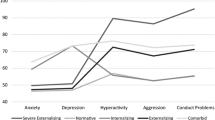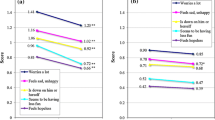Abstract
We examined trajectories of symptom reduction during the course of on-site treatment for behavior problems in pediatric primary-care settings for a subset of children from a larger clinical trial. Participants (N = 80) were children (ages 6–11) referred for treatment due to moderate elevations (≥75th percentile) on the externalizing subscale of the Pediatric Symptom Checklist (PSC-17). The sample was recruited from six pediatric practices in an urban setting. The treatment (Protocol for an Office-based Nurse-administered Intervention; PONI) was administered on-site by trained nurses over the course of 3–6 months. Overall, symptom reduction from the first session to last session was moderate (ES = 0.61) and gradual. Roughly two-thirds (72%) of symptom reduction took place over the first 8 weeks of treatment. The average trajectory of symptom reduction was characterized by a negative slope that flattened over time, consistent with a quadratic growth model. Initial symptom severity predicted final symptom severity (r = .36, P < .01), even though patients with greater initial symptom severity remained in treatment for a significantly greater number of sessions (r = .24, P < .05). The implications of these findings for enhancing the efficiency and effectiveness of treatment are discussed.





Similar content being viewed by others
References
Bickman, L., Andrade, A. R., & Lambert, E. W. (2002). Dose response in child and adolescent mental health services. Mental Health Services Research, 4, 57–60.
Cannon, J. A. N., Warren, J. S., Nelson, P. L., & Burlingame, G. M. (2010). Change trajectories for the youth outcome questionnaire self-report: Identifying youth at risk for treatment failure. Journal of Clinical Child & Adolescent Psychology, 39(3), 289–301. doi:10.1080/15374411003691727.
Chorpita, B. F., Daleiden, E. L., & Weisz, J. R. (2005). Identifying and selecting common elements of evidence based interventions: A distillation and matching model. Mental Health Services Research, 7(1), 5–20. doi:10.1007/s11020-005-1962-6.
Costello, E. J. (1989). Child psychiatric disorders and their correlates: A primary care pediatric sample. Journal of the American Academy of Child & Adolescent Psychiatry, 28(6), 851–855.
Gardner, W., Murphy, J. M., Childs, G., Kelleher, K., Pagano, M. E., Jellinek, M. S., et al. (1999). The PSC-17: A brief pediatric symptom checklist with psychosocial problem subscales. A report from PROS and ASPN. Ambulatory Child Health, 5, 225–236.
Garland, A. F., Hawley, K. M., Brookman-Frazee, L., & Hurlburt, M. S. (2008). Identifying common elements of evidence-based psychosocial treatments for children’s disruptive behavior problems. Journal of the American Academy of Child and Adolescent Psychiatry, 47(5), 505–514.
Gaynor, S. T., Weersing, V. R., Kolko, D. J., Birmaher, B., Heo, J., & Brent, D. A. (2003). The prevalence and impact of large sudden improvements during adolescent therapy for depression: A comparison across cognitive-behavioral, family, and supportive therapy. Journal of Consulting and Clinical Psychology, 71(2), 386–393. doi:10.1037/0022-006X.71.2.386.
Hayes, A. M., Laurenceau, J., Feldman, G., Strauss, J. L., & Cardaciotto, L. (2007). Change is not always linear: The study of nonlinear and discontinuous patterns of change in psychotherapy. Clinical Psychology Review, 27(6), 715–723. doi:10.1016/j.cpr.2007.01.008.
Howard, K. I., Moras, K., Brill, P. L., Martinovich, Z., & Lutz, W. (1996). Evaluation of psychotherapy: Efficacy, effectiveness, and patient progress. American Psychologist, 51(10), 1059–1064. doi:10.1037/0003-066X.51.10.1059.
Ilardi, S. S., & Craighead, W. E. (1994). The role of nonspecific factors in cognitive behavior therapy for depression. Clinical Psychology: Science and Practice, 1(2), 138–156.
Kazdin, A. E., Holland, L., & Crowley, M. (1997). Family experience of barriers to treatment and premature termination from child therapy. Journal of Consulting and Clinical Psychology, 65(3), 453–463.
Kazdin, A. E., & Wassell, G. (1999). Barriers to treatment participation and therapeutic change among children referred for conduct disorder. Journal of Consulting and Clinical Psychology, 28(2), 160–172.
Kolko, D. J. (1995). Multimodal partial-day treatment of child antisocial behavior: Service description and multi-level program evaluation. Continuum: Developments in Ambulatory Mental Health Care, 2, 3–24.
Kolko, D. J., Campo, J. V., Kelleher, K., & Cheng, Y. (2010). Improving access to care and clinical outcome for pediatric behavioral problems: A randomized trial of a nurse-administered intervention in primary care. Journal of Developmental and Behavioral Pediatrics, 31(5), 393–404. doi:10.1097/DBP.0b013e3181dff307.
Kolko, D. J., Dorn, L. D., Bukstein, O. G., Pardini, D., Holden, E. A., & Hart, J. (2009). Community vs clinic-based modular treatment of children with early-onset ODD or CD. A clinical trial with 3-year follow-up. Journal of Abnormal Child Psychology, 37, 591–609. doi:10.1007/s10802-009-9303-7.
Lavigne, J. V., Arend, R., Rosenbaum, D., Binns, H. J., Christoffel, K. K., Burns, A., et al. (1998). Mental health service use among young children receiving pediatric primary care. Journal of the American Academy of Child & Adolescent Psychiatry, 37(11), 1175–1183.
Lavigne, J. V., LeBailly, S. A., Gouze, K. R., Binns, H. J., Keller, J., & Pate, L. (2010). Predictors and correlates of completing behavioral parent training for the treatment of oppositional defiant disorder in pediatric primary care. Behavior Therapy, 41(2), 198–211.
Lindhiem, O., & Kolko, D. J. (2010). Trajectories of symptom reduction and engagement during treatment for childhood behavior disorders: Differences across settings. Journal of Abnormal Child Psychology, 38(7), 995–1005. doi:10.1007/s10802-010-9416-z.
Raudenbush, S. W., & Bryk, A. S. (2002). Hierarchical linear models: Applications and data analysis methods (2nd ed.). Thousand Oaks, CA: Sage.
Reyno, S. M., & McGrath, P. J. (2006). Predictors of parent training efficacy for child externalizing behavior problems—a meta-analytic review. Journal of Child Psychology and Psychiatry, 47(1), 99–111. doi:10.1111/j.1469-7610.2005.01544.x.
Salzer, M. S., Bickman, L., & Lambert, E. W. (1999). Dose-effect relationship in children’s psychotherapy services. Journal of Consulting and Clinical Psychology, 67, 228–238.
Tang, T. Z., & DeRubeis, R. J. (1999). Sudden gains and critical sessions in cognitive behavioral therapy for depression. Journal of Consulting and Clinical Psychology, 67(6), 894–904. doi:10.1037/0022-006X.67.6.894.
Turner, K. M. T., & Sanders, M. R. (2006). Help when it’s needed first: A controlled evaluation of brief, preventive behavioral family intervention in a primary care setting. Behavior Therapy, 37(2), 131–142.
Warren, J. S., Nelson, P. L., Mondragon, S. A., Baldwin, S. A., & Burlingame, G. M. (2010). Youth psychotherapy change trajectories and outcomes in usual care: Community mental health versus managed care settings. Journal of Consulting and Clinical Psychology, 78(2), 144–155. doi:10.1037/a0018544.
Acknowledgments
This study was supported by a grant to the second author from the National Institute of Mental Health (MH63272) and by a T32 Fellowship to the first author. The authors acknowledge the research and clinical staff of the (Services for Kids in Primary-Care) SKIP program.
Author information
Authors and Affiliations
Corresponding author
Rights and permissions
About this article
Cite this article
Lindhiem, O., Kolko, D.J. Trajectories of Symptom Reduction During Treatment for Behavior Problems in Pediatric Primary-Care Settings. Adm Policy Ment Health 38, 486–494 (2011). https://doi.org/10.1007/s10488-011-0335-2
Published:
Issue Date:
DOI: https://doi.org/10.1007/s10488-011-0335-2




